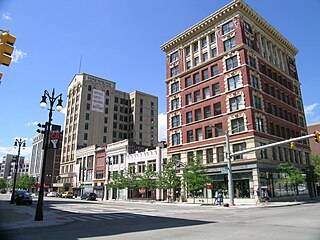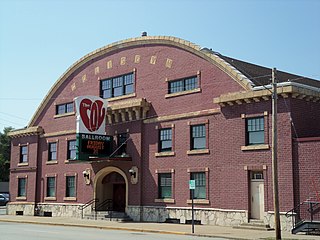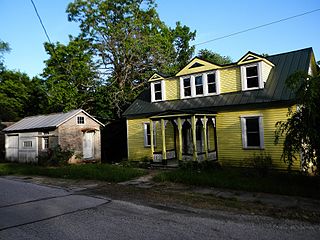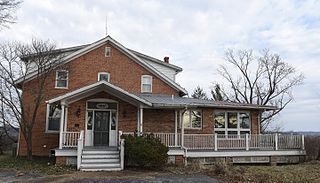
Crimora is a census-designated place (CDP) in Augusta County, Virginia, United States. The population was 2,209 at the 2010 census, a 23% increase from the 1,796 reported in 2000. It is part of the Staunton–Waynesboro Micropolitan Statistical Area.

Meramec State Park is a public recreation area located near Sullivan, Missouri, about 60 miles from St. Louis, along the Meramec River. The park has diverse ecosystems such as hardwood forests and glades. There are over 40 caves located throughout the park, the bedrock is dolomite. The most famous is Fisher Cave, located near the campgrounds. The park borders the Meramec Conservation Area.
The Confederate Memorial State Historic Site is a state-owned property occupying approximately 135 acres (55 ha) near Higginsville, Missouri. From 1891 to 1950, the site was used as an old soldiers' home for veterans of the Confederate States Army after the American Civil War. The Missouri state government then took over operation of the site after the last veteran died in 1950, using it as a state park. In 1981, a cottage, a chapel, and the Confederate cemetery were listed on the National Register of Historic Places as the Confederate Chapel, Cemetery and Cottage. The chapel was moved from its original position in 1913, but was returned in 1978. It has a tower and a stained glass window. The cottage is a small wooden building, and the cemetery contains 723 graves. Within the cemetery is a monument erected by the United Daughters of the Confederacy which is modeled on the Lion of Lucerne. In addition to the cemetery and historic structures, the grounds also contain trails, picnic sites, and fishing ponds.

Sergeant Floyd is a historic museum boat, serving as the Sergeant Floyd River Museum & Welcome Center at 1000 Larsen Park Road in Sioux City, Iowa. Built in 1932 as a utility vehicle and towboat, she is one of a small number of surviving vessels built specifically for the United States Army Corps of Engineers in its management of the nation's inland waterways. The boat has been restored and drydocked, and now houses exhibits about the Missouri River and local tourism information. The museum is a facility of the Sioux City Public Museum.

The Harmonie Club is a club located at 267 East Grand River Avenue in Downtown Detroit, Michigan. It was designated a Michigan State Historic Site in 1975 and listed on the National Register of Historic Places in 1980.

The Harmonie Centre, also known as the Breitmeyer–Tobin Building, is an eight-story commercial building located at 1308 Broadway Street in Downtown Detroit. It is part of the Broadway Avenue Historic District. It is also known as the Tobin Building. The building was listed on the National Register of Historic Places in 1980. The east necklace of downtown links Grand Circus and the stadium area to Greektown along Broadway. The east necklace contains a sub-district sometimes called the Harmonie Park District, which has taken on the renowned legacy of Detroit's music from the 1930s through the 1950s and into the present.

The Broadway Avenue Historic District is a historic district located on a single city block along Broadway Avenue between Gratiot and East Grand River in downtown Detroit, Michigan. It was listed on the National Register of Historic Places in 2004. The Broadway Avenue Historic District joins the Randolph Street Commercial Buildings Historic District, a rare surviving commercial area which dates from the 1840s.
Roaring River State Park is a public recreation area covering of 4,294 acres (1,738 ha) eight miles (13 km) south of Cassville in Barry County, Missouri. The state park offers trout fishing on the Roaring River, hiking on seven different trails, and the seasonally open Ozark Chinquapin Nature Center.

U.S. Route 64 is a U.S. highway running from Teec Nos Pos, Arizona east to Nags Head, North Carolina. In the U.S. state of Arkansas, the route runs 246.35 miles (396.46 km) from the Oklahoma border in Fort Smith east to the Tennessee border in Memphis. The route passes through several cities and towns, including Fort Smith, Clarksville, Russellville, Conway, Searcy, and West Memphis. US 64 runs parallel to Interstate 40 until Conway, when I-40 takes a more southerly route.

The John W. Boone House, also known as the Stuart P. Parker Funeral Home, is a historic home located at Columbia, Missouri. It was built about 1890, and is a two-story frame house that measures roughly 46 feet by 45 feet. It was the home of ragtime musician John William 'Blind' Boone. The home, which is owned by the City of Columbia, had fallen into a state of severe disrepair, but is now under restoration

The Col Ballroom is a historic building located in the West End of Davenport, Iowa, United States. It was listed on the National Register of Historic Places and on the Davenport Register of Historic Properties as the Saengerfest Halle.

Henry Mish Barn, also known as Mish Barn and Heritage Hill Barn, is a historic Pennsylvania bank barn located near Middlebrook, Augusta County, Virginia. It was built about 1849, and measures 50 feet by 100 feet. The ends of the barn feature decorative brick lattice vents in lozenge patterns, a feature prevalent in Pennsylvania barns. It is one of the few pre-American Civil War examples to have survived the Valley barn-burning campaigns by Union forces. Associated with the brick barn are the contributing Mish House and two related outbuildings. The barn was built for Henry Mish, a native of York County, Pennsylvania who settled in southwestern Augusta County in 1839.

The August Sehrt House is a historic home located at Augusta, St. Charles County, Missouri. It was built about 1860 by German immigrant, August Sehrt. He came to America in 1848 with several family members, including his brother, Julius Sehrt who went on to become the most extensive land owner in St. Charles, MO. It is a 1+1⁄2-story, five bay, brick dwelling on a stone foundation and with a side-gable roof. The building houses the Augusta History Museum.

Charles McLee Farris House is a historic home located at Augusta, St. Charles County, Missouri. It was built about 1850, and is a 1+1⁄2-story, three bay, frame dwelling on a stone foundation and with a saddlebag plan. The house measures approximately 32 feet wide and 30 feet deep. It has a side gable roof with dormer and one-bay front porch.
Dr. C. L. Gerling House is a historic home located at Augusta, St. Charles County, Missouri. It was built about 1850, and is a 1+1⁄2-story, half-timber frame dwelling sheathed in weatherboard. The house measures approximately 27 feet wide and 35 feet deep. It has a side gable roof and sits on a stone foundation.

J. F. Schroer House-Store is a historic home and store located at Augusta, St. Charles County, Missouri. The house was built about 1865–1866, and is a 2+1⁄2-story, brick dwelling with a central passage plan. The store occupied the first floor with living quarters above. It measures approximately 50 feet wide by 36 feet deep and has a side-gable roof and wine cellar.

Staudinger–Grumke House–Store is a historic home and store located at Augusta, St. Charles County, Missouri. The house was built about 1859 by August Staudinger, and was later purchased by George Grumke in 1873, who used the structure to operate a saloon on the ground floor. The property was in the Grumke family until 1932.

Robert Ewich Farmstead is a historic home and farm located at Augusta, St. Charles County, Missouri. The house was built about 1865, and is a two-story, three-bay, front-gabled, red brick dwelling on a stone foundation. The house measures approximately 35 feet wide and 30 feet deep and has a central-passage plan. Also on the property is a contributing board-and-batten barn dated to about 1865.
The Harold–Knoernschild Farmstead Historic District, also known as Centennial Farms, is a historic home and farm and national historic district located at Augusta, St. Charles County, Missouri. The house was built about 1836, and is a two-story, log farmhouse sheathed in weatherboard. A one-story brick addition was constructed about 1882. The house features a stone chimney with hearths on both stories and a two-story, full facade porch. Also on the property is a contributing board-and-batten barn dated to about 1860 and two early-20th century farm outbuildings. The house was built by Leonard Harold, founder of Augusta.

The Missouri Lumber and Mining Company (MLM) was a large timber corporation with headquarters and primary operations in southeast Missouri. The company was formed by Pennsylvania lumbermen who were eager to exploit the untapped timber resources of the Missouri Ozarks to supply lumber, primarily used in construction, to meet the demand of U.S. westward expansion. Its primary operations were centered in Grandin, a company town it built starting c. 1888. The lumber mill there grew to be the largest in the country at the turn of the century and Grandin's population peaked around 2,500 to 3,000. As the timber resources were exhausted, the company had to abandon Grandin around 1910. It continued timber harvesting in other parts of Missouri for another decade. While some of the buildings in Grandin were relocated, many of the remaining buildings were listed on the National Register of Historic Places in 1980 as part of the state's historic preservation plan which considered the MLM a significant technological and economic contributor to Missouri.



















